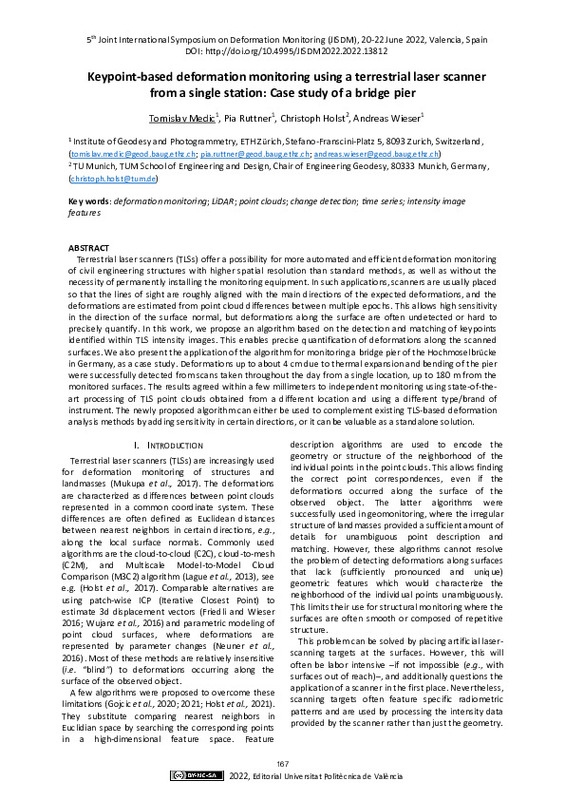JavaScript is disabled for your browser. Some features of this site may not work without it.
Buscar en RiuNet
Listar
Mi cuenta
Estadísticas
Ayuda RiuNet
Admin. UPV
Keypoint-based deformation monitoring using a terrestrial laser scanner from a single station: Case study of a bridge pier
Mostrar el registro sencillo del ítem
Ficheros en el ítem
| dc.contributor.author | Medic, Tomislav
|
es_ES |
| dc.contributor.author | Ruttner, Pia
|
es_ES |
| dc.contributor.author | Holst, Christoph
|
es_ES |
| dc.contributor.author | Wieser, Andreas
|
es_ES |
| dc.date.accessioned | 2023-03-01T11:19:23Z | |
| dc.date.available | 2023-03-01T11:19:23Z | |
| dc.date.issued | 2023-01-27 | |
| dc.identifier.isbn | 9788490489796 | |
| dc.identifier.uri | http://hdl.handle.net/10251/192196 | |
| dc.description.abstract | [EN] Terrestrial laser scanners (TLSs) offer a possibility for more automated and efficient deformation monitoring of civil engineering structures with higher spatial resolution than standard methods, as well as without the necessity of permanently installing the monitoring equipment. In such applications, scanners are usually placed so that the lines of sight are roughly aligned with the main directions of the expected deformations, and the deformations are estimated from point cloud differences between multiple epochs. This allows high sensitivity in the direction of the surface normal, but deformations along the surface are often undetected or hard to precisely quantify. In this work, we propose an algorithm based on the detection and matching of keypoints identified within TLS intensity images. This enables precise quantification of deformations along the scanned surfaces. We also present the application of the algorithm for monitoring a bridge pier of the Hochmoselbrücke in Germany, as a case study. Deformations up to about 4 cm due to thermal expansion and bending of the pier were successfully detected from scans taken throughout the day from a single location, up to 180 m from the monitored surfaces. The results agreed within a few millimeters to independent monitoring using state-of-the-art processing of TLS point clouds obtained from a different location and using a different type/brand of instrument. The newly proposed algorithm can either be used to complement existing TLS-based deformation analysis methods by adding sensitivity in certain directions, or it can be valuable as a standalone solution. | es_ES |
| dc.format.extent | 9 | es_ES |
| dc.language | Inglés | es_ES |
| dc.publisher | Editorial Universitat Politècnica de València | es_ES |
| dc.relation.ispartof | 5th Joint International Symposium on Deformation Monitoring (JISDM 2022) | |
| dc.rights | Reconocimiento - No comercial - Compartir igual (by-nc-sa) | es_ES |
| dc.subject | Light detection and ranging (LiDAR) | es_ES |
| dc.subject | Deformation monitoring | es_ES |
| dc.subject | Point clouds | es_ES |
| dc.subject | Change detection | es_ES |
| dc.subject | Time series | es_ES |
| dc.subject | Intensity image features | es_ES |
| dc.title | Keypoint-based deformation monitoring using a terrestrial laser scanner from a single station: Case study of a bridge pier | es_ES |
| dc.type | Capítulo de libro | es_ES |
| dc.type | Comunicación en congreso | es_ES |
| dc.identifier.doi | 10.4995/JISDM2022.2022.13812 | |
| dc.rights.accessRights | Abierto | es_ES |
| dc.description.bibliographicCitation | Medic, T.; Ruttner, P.; Holst, C.; Wieser, A. (2023). Keypoint-based deformation monitoring using a terrestrial laser scanner from a single station: Case study of a bridge pier. En 5th Joint International Symposium on Deformation Monitoring (JISDM 2022). Editorial Universitat Politècnica de València. 167-175. https://doi.org/10.4995/JISDM2022.2022.13812 | es_ES |
| dc.description.accrualMethod | OCS | es_ES |
| dc.relation.conferencename | 5th Joint International Symposium on Deformation Monitoring | es_ES |
| dc.relation.conferencedate | Junio 20-22, 2022 | es_ES |
| dc.relation.conferenceplace | València, España | es_ES |
| dc.relation.publisherversion | http://ocs.editorial.upv.es/index.php/JISDM/JISDM2022/paper/view/13812 | es_ES |
| dc.description.upvformatpinicio | 167 | es_ES |
| dc.description.upvformatpfin | 175 | es_ES |
| dc.type.version | info:eu-repo/semantics/publishedVersion | es_ES |
| dc.relation.pasarela | OCS\13812 | es_ES |








